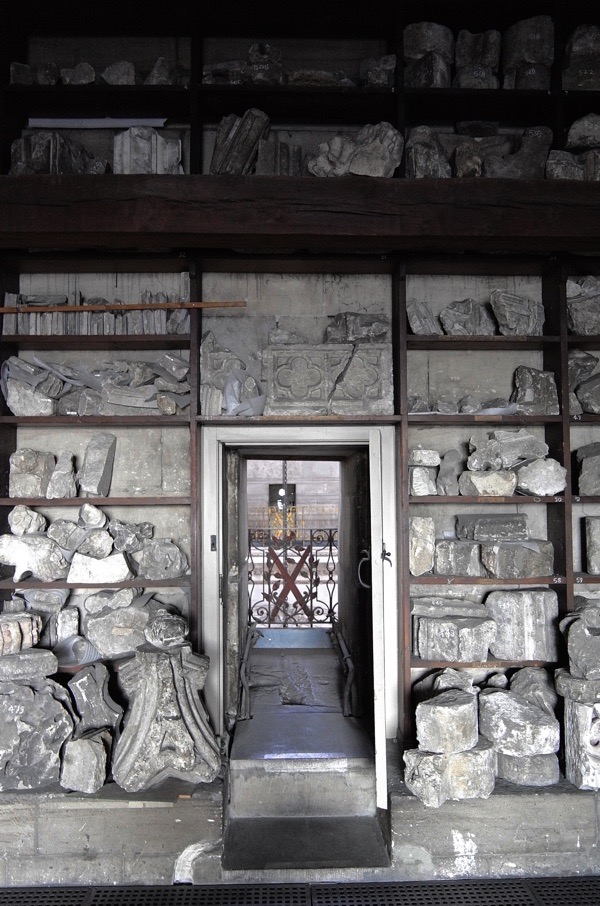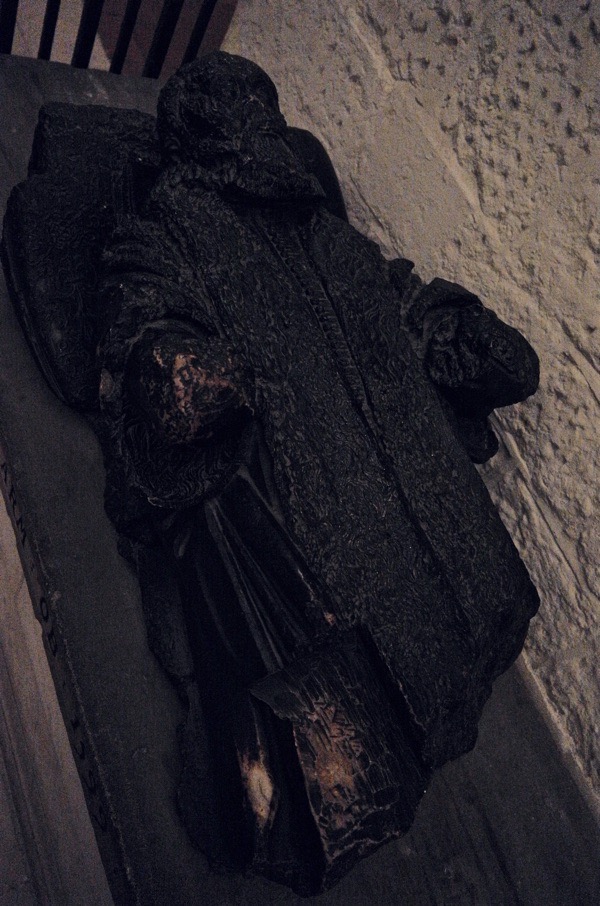cultură şi spiritualitate
Three hundred and fifty years ago today, on 2nd September 1666, the Great Fire of London started

Fragments of Old St Paul’s stored in the triforium at New St Paul’s
Sir Christopher Wren’s success at St Paul’s Cathedral is to have envisaged architecture of such absolute assurance that it is impossible to imagine it could ever have been any different than it is today. Yet Wren was once surveyor of Old St Paul’s, confronted daily with a tottering gothic pile and carrying the onerous responsibility for this vast medieval shambles upon his shoulders, until the Great Fire took it away three hundred and fifty years ago.
The spire of Old St Paul’s collapsed in 1561 and, in Wren’s, time wooden scaffolding was necessary to hold up the poorly-built Cathedral. Parts of the cloister were carried off to build Somerset House and even a fancy new portico designed in the classical style by Inigo Jones failed to ameliorate the general picture of decay and dereliction.
When the Great Fire of London began in September 1666, the Stationers Company stored their books and paper in the crypt of the Cathedral for safe-keeping and residents piled their precious furniture in the churchyard – one of the few open spaces in the City – so that it might be safe even if they lost their homes in the conflagration. These prudent measures only exacerbated the catastrophe when a spark set fire to the wooden roof of the Cathedral which collapsed into the crypt, sending a river of molten lead running down Ludgate Hill, igniting a violent inferno of paper that brought down the entire building and consumed all the furniture in the churchyard as well.
After the pyre of Old St Paul’s was at last extinguished in September, weeks after the Fire had been quenched elsewhere in the City, it became a popular pastime to scavenge through the ruins for souvenirs. You might assume nothing survived but, if you know where to look and what to look for, there are relics scattered throughout New St Paul’s.
Commemorating the three hundred and fiftieth anniversary of the destruction of Old St Paul’s, I thought I would make a photographic inventory of what is left. There are Roman tiles, an Anglo-Saxon hog’s back tomb, a Viking grave marker and multiple stone fragments of the Cathedral itself, catalogued in the nineteenth century – although I was most fascinated by seventeenth-century effigies that withstood the Fire.
Medieval monuments and statuary were destroyed in the Reformation, and Oliver Cromwell famously stabled his horses in the Cathedral at the time of the English Revolution, but there was a brief period when new monuments and figures were installed prior to the Great Fire of London and a handful of these remain today.
John Donne would have conjured an astute sonnet upon the metaphysical irony of his monument being the only one surviving intact. In his last days, he insisted upon modelling for his own effigy, wrapped in a shroud, and the resultant sculpture is distinguished by remarkably naturalistic drapery. Yet, in spite of this, I can only see it as an image of a flame in which the great poet glimmers eternally.
A small collection of seventeenth-century human effigies rest down in the crypt, burnt black by the Fire. Carved from pale marble or alabaster, they have been transfigured by the furnace-like temperature of the conflagration and emerged charcoal-black, glistening and broken, as if they had been excavated like coal – as if they were creatures of another time, as remote as prehistoric creatures. But, even as they were ravaged by apocalyptic lfire and damaged beyond recognition, some have retained fine detail of armour and clothing, and all have acquired presence. These compelling fragmentary forms are worthy of Henry Moore, charmed stones that manifest an eternal spirit forged in fire.
Unsurprisingly, Christopher Wren had little interest in the relics of Old St Paul’s because he was looking to the future. Wary of medieval foundations, he had his New St Paul’s re-aligned to avoid them. Yet, although Wren had most of the ancient stone broken up to use as infill for New St Paul’s, there are a couple of spots in the crypt where you can see fragments of detailed Romanesque carving sticking out from the wall, hidden in plain sight, to remind us that – even though Old St Paul’s has gone – it is still with us.

Roman tiles and Anglo-Saxon grave cover in the triforium

Hogback grave cover, dating from 1000-1050 AD, possibly from the grave of King Athelstan

Viking grave marker, dating from 1125-50AD, dug up in 1852 in the churchyard

Twelfth century Romanesque carving of foliage in the wall of the crypt

Twelfth century Romanesque carving of foliage in the wall of the crypt

Ledger stone of Brian Walton, Bishop of Chester, died 1661

Sir John & Eliza Wolley

Sir John Wolley, Latin Secretary to Elizabeth I, died 1596

Eliza Wolley, Lady of the Privy Chamber to Elizabeth I, died 1600

Sir Thomas Heneage Vice-Chamberlain to Elizabeth I, died 1594, & Anna Heneage, died 1592

Unknown effigy

Unknown effigy

William Cokain, Mayor of London 1619, died 1626

William Cokain, Mayor of London 1619, died 1626

John Donne, Poet & Dean of St Paul’s (1572-1631), monument by Nicholas Stone

Caen & Reigate stones from Old St Paul’s (1180-1666 AD) excavated by Francis Penrose, Cathedral Surveyor in the nineteenth century


This lion is a fragment of Inigo Jones portal to St Paul’s which inspired Christopher Wren


Click to enlarge this comparative plan of 1872 which superimposes the outlines of Old and New St Paul’s (Reproduced courtesy of St Paul’s)
A programme of walks, talks and tours, special sermons & debates to mark the 350th anniversary of the Great Fire of London is runs at St Paul’s until April 2017. Click here to learn more about the Fire at St Paul’s
You may also like to read my other stories of St Paul’s Cathedral
Adaugă un comentariu
© 2024 Created by altmarius.
Oferit de
![]()
Embleme | Raportare eroare | Termeni de utilizare a serviciilor














Pentru a putea adăuga comentarii trebuie să fii membru al altmarius !
Alătură-te reţelei altmarius